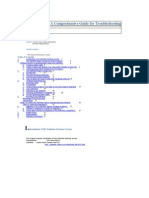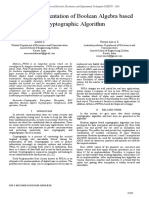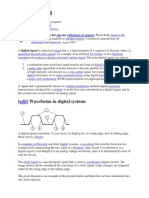A New Cryptosystem With Four Levels of Encryption and Parallel Programming
Uploaded by
CS & ITA New Cryptosystem With Four Levels of Encryption and Parallel Programming
Uploaded by
CS & ITA NEW CRYPTOSYSTEM WITH FOUR
LEVELS OF ENCRYPTION AND PARALLEL
PROGRAMMING
Parag A. Guruji
Department of Computer Science and Engineering,
Walchand College of Engineering Sangli (An Autonomous Institute)
Vishrambag, Sangli, Maharashtra, India- 416415
gurujipa@gmail.com
ABSTRACT
Evolution in the communication systems has changed the paradigm of human life on this planet.
The growing network facilities for the masses have converted this world to a village (or may be
even smaller entity of human accommodation) in a sense that every part of the world is
reachable for everyone in almost no time. But this fact is also not an exception for coins having
two sides. With increasing use of communication networks the various threats to the privacy,
integrity and confidentiality of the data sent over the network are also increasing, demanding
the newer and newer security measures to be implied. The ancient techniques of coded
messages are imitated in terms of new software environments under the domain of
cryptography. The cryptosystems provide a means for the secured transmission of data over an
unsecured channel by providing encoding and decoding functionalities. This paper proposes a
new cryptosystem based on four levels of encryption. The system is suitable for communication
within the trusted groups.
KEYWORDS
Matrix transformation, Fractionification, Re-integerization, Change of radix
1. INTRODUCTION
A cryptosystem refers to a suite of algorithms needed to implement a particular form of
encryption and decryption. The encryption operations are the transformation functions with the
set of all symbols which appear in data to be encrypted as their domain and the set of all
corresponding encoded symbols as their codomain. The basic characteristic of any encryption
operation for the faithful transmission of data is its reversibility. Any encryption operation that
transforms input data into some encoded form must work as a bijective mapping, whose inverse
exists and is also a bijective mapping. These criteria if not satisfied, the retrieval of the data from
its encoded form back to its original form cannot be assured. Following figure represents the
encryption operation f and its inverse f-1 (called decryption operation) as the bijective mappings
from their corresponding domain and codomain.
David C. Wyld et al. (Eds) : CSEN, AISO, NCWC, SIPR - 2015
pp. 1119, 2015. CS & IT-CSCP 2015
DOI : 10.5121/csit.2015.51402
12
Computer Science & Information Technology (CS & IT)
Figure 1. The encryption and decryption operations as mappings
In this paper the author proposes a new cryptosystem for the implementation in form of an
application able to perform all the encryption and decryption tasks in an abstracted manner and
thus keeping all of them transparent to only the valid user. The system operates on four levels of
layers of the encryption making the complexity of cracking it extremely high. The four layers
refer to the different set of operations, undergoes which the user data. The fragmentation and reorganization of the data is to be done as preprocessing before passing it to the encryption module.
On the other side the decryption module works for the retrieval of encrypted data from the
chunks that it receives and reorganizes it by sorting the randomly received chunks; after
performing the four decryption operations on it which are inverses of the four encryption
operations.
The encryption operations are:
1. Matrix transformation
2. Fractionification
3. Random no. addition
4. Change of radix
The decryption operations are:
1. Change of radix
2. Random no. removal
3. Re-integerization
4. Matrix re-transformation
The key generation operations are:
1. Random no. generation
2. Matrix generation using corresponding polynomial and checking for its inevitability
3. Radix generation using corresponding polynomial.
Computer Science & Information Technology (CS & IT)
13
2. THE FUNCTIONAL DESIGN
2.1. Defining Tasks
To perform the operations in a systematic manner, the author defines the tasks to be performed on
both the sides, the encryption and decryption as follows:
2.1.1. Encryption Tasks
1. Fragmentation of input data into chunks and indexing them.
2. Generation of the random key for each chunk and thus that of the key matrix and key
radix.
3. Operating each chunk with encryption operations in the sequence in which they are listed
above.
4. Augmentation of encrypted chunk with corresponding key which is a mere random
integer.
2.1.2. Decryption Tasks
1. Receipt of the encrypted chunk and separation of key
2. Generation of the key matrix and key radix for received chunk.
3. Operating each chunk with decryption operations.
4. Reorganization of the chunks using the indices to retrieve data in its original form.
The selection/formation of polynomials required for the key generation are left on the
implementation to keep this design flexible. The complexity of these polynomials will add to the
complexity of whole of the system.
2.2. Task Accomplishment Scheme
The scheme for completing each of the above tasks is discussed in this section.
2.2.1. Fragmentation of input data into chunks and indexing:
The input data is fragmented in the chunks, each of size s bytes where s is the implementationspecific size defined for representation of an integer. The data structure to be used store these
fragments is a linear list, each node of which contains a chunk and an index value representing
the offset of that chunk from the beginning of the input data in terms of no. of chunks. Along
with these two values, the chunk contains space for its key value, a random integer generated by
the key generator. This fragmentation of the data enables the parallel functioning of every step to
follow as discussed later in the paper.
14
Computer Science & Information Technology (CS & IT)
2.2.2. Generation of the random key for each chunk and thus that of the key matrix and key
radix:
A random number is to be generated (generation implementation specific) for each chunk and is
then assigned as the key for that chunk. The selected polynomials are provided with this key to
generate the key matrix and key radix for that chunk. The implementation must take care that the
generated matrix will be an invertible (non singular) matrix. After completion of this step we are
ready with required input values for the computation of the encrypted counterparts of each
element in the input data.
2.2.3. Operating each chunk with encryption operations:
2.2.3.1. Matrix transformation:
The chunk formed along with the source file identifier (A random no. assigned to the source-file)
and excluding the key is represented as a 31 matrix and is multiplied with the 33 matrix
generated using the key (key matrix) to get the transformed matrix of order 31.
2.2.3.2. Fractionification:
The term Fractionification is defined as the conversion function which maps an integer to a
fraction by dividing the integer by Rd where R is the radix of the number system under
consideration and d is no. of significant digits in the original integer and then adding to it the
integer value d. Thus, for an integer I in number system with radix R having d significant digits,
fractionification is defined as,
(I) = I (Rd) + d
2.2.3.3. Random no. addition:
The fractionified no is then added with some random number multiplied by 10 to preserve the
value of d (the no of significant digits in original no.). Thus, the integer I when fractionified and
added with random no. becomes r(I) given by,
r(I) = (I) + n10
where, n is the random number generated.
2.2.3.4. Change of radix:
Now that we have converted the integer I, representing s bytes of input data, to a floating point
equivalent r(I), the radix of the number system is to be changed as the outermost encoding
operation. It is defined as the combination of two simple radix conversion operations, one for the
integer part of the input floating point no. and other for its fraction part, represented as an integer.
The target radix selection is important task and is selected using a randomization polynomial
(implementation specific) with the key of corresponding chunk as its parameter. To use radix
greater than 10, the corresponding symbols used are capital and small scripts of English alphabets
and related numerical operations on them are to be defined.
Computer Science & Information Technology (CS & IT)
15
2.2.4. Augmentation of encrypted chunk with corresponding key:
Once each element in the chunk except the key are encrypted, the chunk is augmented with the
key, applied with fractionification and random no. addition, and thus is ready for the
transmission.
2.2.5. Receipt of the encrypted chunk and separation of key:
The chunk when received on decryption end, it is to be stored in the buffer for unresolved
chunks. From the key field the value of key is found and separated out and the corresponding key
matrix and key radix are calculated exactly as explained above. The inverse of this matrix is
calculated by adjoint method to get the decryption matrix.
2.2.6. Operating each chunk with decryption operations:
2.2.6.1. Change of radix:
Each element in the received chunk is operated on by the inverse change of radix with source
radix as the one derived from the key and 10 as the target radix. Obviously, the integer and
fraction part are treated individually treated as different integers, and then combined back.
2.2.6.2. Random no. removal:
Each element of the chunk is then operated upon by the inverse of the random no. addition to get
the fractionified value using following function,
(I) = (r(I)%10)
2.2.6.3. Re-integerization:
The term Re-integerization is defined as the inverse function of Fractionification which maps to
an integer, its equivalent fractionified value, and is defined as,
I = ((I) %1) 10d
where,
d = ( ( I )%10)
2.2.6.4. Matrix re-transformation:
The chunk received is in the form of 31 matrix. It is multiplied by the 33 decryption matrix
determined for that chunk according to the simple matrix multiplication to get the original data
chunk.
2.2.7. Reorganization of the chunks
Now that having done with the decryption operations on received chunks, they are to be
reorganized in the sequence of that of the data contained by them in the original source file. This
is achieved by sorting the randomly placed data chunks using the identifier and index fields as the
key. To boost the efficiency of sorting, author proposes to form a Binary Search Tree for each
identifier and then the chunks are to be added in it according to the index field values as the key.
Once the no. of nodes in the tree approaches to the total count of chunks present in the index field
16
Computer Science & Information Technology (CS & IT)
of identifier node, i.e. the root, the tree is traversed in In-order manner (left-root-right) and data
field contents of each node are written into the destination file during traversal.
3. SECURITY FACTORS
The security and confidentiality of the data are the fundamental goals of any cryptosystem. In
case of the proposed system, though all of such factors already have appeared in the discussion
up till now, in this section we identify and enlist each of them for the getting the view of the
security provided by the system as a whole.
1. Randomness of the key
2. Secrecy and complexity of the polynomials used for matrix and radix generation
3. Individual random key for each chunk: This removes the threat by many of the pattern
analysis and known text attacks
4. Matrix Transformation: This transforms chunk into an integral unit whose meaning cannot be
derived without accurate inverse of key matrix
5. Fractionification and Random no. addition: This covers the transformation and makes it too
complex to analyze the resultant patterns and detect the transformation
6. Change of Radix: This changes the representation of the numbers and thus adding to the
complexity of analysis of interrelations of elements in resultant values.
4. THE PARALLEL PROGRAMMING APPROACH
The important feature of proposed design of cryptosystem in this paper is the fragmentation of
data and independency of the key for each fragment. This independence allows the parallel
functioning of different modules in of cryptosystem. Each node follows the same path after the
fragmentation is done. Thus after completion of Task 1on encryption side, each chunk is
proposed to be processed in parallel through the completion of encryption. Also on decryption
side, the received nodes are proposed to get processed in parallel till their addition to
corresponding BST. This will reduce the time complexity of the cryptosystem application by the
factor of n-1 where, n is the no. of fragments.
Along with this first level of parallel programming, the efficiency can further be increased by
incorporating the second level of the same. In the second level, within each fragment the different
elements are proposed to be operated with all the encryption as well as decryption functions
independently except the matrix transformation. This will bring the time complexity to Time
complexity of matrix multiplication + 3-1 (time complexity of rest of the operations with
sequential approach), Thus reducing it roughly by factor of 3-1.
The author further proposes the third level of parallel programming, involving the parallel
implementation of the matrix multiplication itself to further boost the efficiency. Thus the parallel
programming approach adds to the efficiency significantly.
Computer Science & Information Technology (CS & IT)
5. FLOWCHARTS
4.1. Encryption Flowchart:
Start
Fragment and store data to indexed linear list
Perform in parallel
for each not of
the list
Form the key, key matrix and key radix for the chunk
Encrypt the node data by matrix transformation
Convert each entry to the number system with radix = key radix
Fractionify each entry
Add randomly generated integer to each fractionified entry
Return encrypted chunk of data
Stop
17
18
Computer Science & Information Technology (CS & IT)
4.2. Decryption Flowchart:
Start
Receive encrypted chunk, spawn new thread and separate key
Remove random number addition
Re-integerize each entry and convert to decimal system
Is first row of
decrypted
matrix
NULL?
Create new BST
Insert 2nd and 3rd
elements of
decrypted array to
data and index
attributes resp. of
new node of the BST
indicated by the 1st
Retrieve data in sequence from BST by in-order traversal
Stop
Computer Science & Information Technology (CS & IT)
19
5. CONCLUSIONS
The cryptosystem proposed in the paper works on four different layers of the encryption. All the
layers cover the possible attacks on its inner layer making the encryption extremely complex to
crack. The security factors of the system protect it against the cracking attacks. The polynomials
and random number generators are left to the implementation for making the system flexible.
This incurs the variation of complexity of encryption depending on the implementation. The
parallel approach of programming adds to the efficiency of application significantly, as discussed
in the section II.
REFERENCES
[1]
Yi-Shiung Yeh, Tzong Chen Wu, Chin Chen Chang and Wei Chizh Yang A New Cryptosystem
using Matrix Transformation, Proceedings. 25th Annual IEEE International Carnahan Conference
on Security Technology 1991 (Cat. No.91CH3031-2)
[2]
D. C. Lay Linear Algebra ISBN: 9781405846219, Chapters 1, 2 and 3
AUTHORS
Parag A. Guruji
Earned Bachelor of Technology degree in
Computer Science and Engineering from
Walchand College of Engineering, Sangli, India
in May 2014.
Working at ZLemma Analytics in Data Science
team since June 2014
You might also like
- A Novice Encryption Technique Cryptographic Algorithm Using Substitution Time ClockNo ratings yetA Novice Encryption Technique Cryptographic Algorithm Using Substitution Time Clock7 pages
- a-new-cryptosystem-for-ciphers-using-transposition-techniques-IJERTV8IS040323No ratings yeta-new-cryptosystem-for-ciphers-using-transposition-techniques-IJERTV8IS0403235 pages
- encryption-based-on-matrix-transformation-technique-IJERTCONV2IS04076No ratings yetencryption-based-on-matrix-transformation-technique-IJERTCONV2IS040765 pages
- Cryptography and Cyber security hints pdfNo ratings yetCryptography and Cyber security hints pdf25 pages
- Multiple Text Cryptanalysis by Using Matrix and Logical OperationsNo ratings yetMultiple Text Cryptanalysis by Using Matrix and Logical Operations3 pages
- 0f2f3709-ecb6-40d6-a32e-fd99b2d52d83_IJATER_17_07No ratings yet0f2f3709-ecb6-40d6-a32e-fd99b2d52d83_IJATER_17_075 pages
- A Cryptographic Scheme For Construction of SubstitNo ratings yetA Cryptographic Scheme For Construction of Substit9 pages
- Efficient Digital Encryption Algorithm Based On Matrix Scrambling TechniqueNo ratings yetEfficient Digital Encryption Algorithm Based On Matrix Scrambling Technique12 pages
- Cipher Craft Design and Analysis of Advanced CryptNo ratings yetCipher Craft Design and Analysis of Advanced Crypt11 pages
- 2011 An Enhanced Cryptographic Substitution Method For Information SecurityNo ratings yet2011 An Enhanced Cryptographic Substitution Method For Information Security6 pages
- Amey B-50 System Security Lab Experiment-1No ratings yetAmey B-50 System Security Lab Experiment-117 pages
- High Efficient Complex Parallelism For CryptographyNo ratings yetHigh Efficient Complex Parallelism For Cryptography7 pages
- 16BCS2349 Jaspreet Singh IIS Worksheet 1No ratings yet16BCS2349 Jaspreet Singh IIS Worksheet 16 pages
- Network Security Using A Symmetric Key CryptographyNo ratings yetNetwork Security Using A Symmetric Key Cryptography2 pages
- Design and Implementation of a Multi-Algorithm Encryption and Decryption FrameworkNo ratings yetDesign and Implementation of a Multi-Algorithm Encryption and Decryption Framework12 pages
- Implementation of Aes and Blowfish AlgorithmNo ratings yetImplementation of Aes and Blowfish Algorithm4 pages
- Cryptography in Context: Nathaniel KarstNo ratings yetCryptography in Context: Nathaniel Karst15 pages
- Randomized Encryption Cryptosystem: R. Sivaraman Dr. Sonal BhartiNo ratings yetRandomized Encryption Cryptosystem: R. Sivaraman Dr. Sonal Bharti4 pages
- A Cryptographic Technique Involving Substitution Algorithm and Logical OperatorNo ratings yetA Cryptographic Technique Involving Substitution Algorithm and Logical Operator5 pages
- Cryptosoft: Divya G.R. Gigi P.S. Sethuparvathi CNo ratings yetCryptosoft: Divya G.R. Gigi P.S. Sethuparvathi C35 pages
- Cryptographic Algorithms For Secure Data CommunicaNo ratings yetCryptographic Algorithms For Secure Data Communica18 pages
- A New Method For Encryption Using Fuzzy Set TheoryNo ratings yetA New Method For Encryption Using Fuzzy Set Theory7 pages
- Efficient Implementation of Cryptographically Useful"Large" Boolean FunctionsNo ratings yetEfficient Implementation of Cryptographically Useful"Large" Boolean Functions8 pages
- R Fast Track Guide - 86 Key Points Every Programmer from Other Languages Should MasterFrom EverandR Fast Track Guide - 86 Key Points Every Programmer from Other Languages Should MasterNo ratings yet
- Modern C++ Programming: Including the recent standards C++11, C++17, C++20, C++23From EverandModern C++ Programming: Including the recent standards C++11, C++17, C++20, C++23No ratings yet
- CISCO PACKET TRACER LABS: Best practice of configuring or troubleshooting NetworkFrom EverandCISCO PACKET TRACER LABS: Best practice of configuring or troubleshooting NetworkNo ratings yet
- Cisco Packet Tracer Implementation: Building and Configuring Networks: 1, #1From EverandCisco Packet Tracer Implementation: Building and Configuring Networks: 1, #1No ratings yet
- International Journal of Game Theory and Technology (IJGTT)No ratings yetInternational Journal of Game Theory and Technology (IJGTT)2 pages
- International Journal of Game Theory and Technology (IJGTT)No ratings yetInternational Journal of Game Theory and Technology (IJGTT)2 pages
- Call For Papers-The International Journal of Ambient Systems and Applications (IJASA)No ratings yetCall For Papers-The International Journal of Ambient Systems and Applications (IJASA)2 pages
- International Journal of Game Theory and Technology (IJGTT)No ratings yetInternational Journal of Game Theory and Technology (IJGTT)2 pages
- Call For Papers-The International Journal of Ambient Systems and Applications (IJASA)No ratings yetCall For Papers-The International Journal of Ambient Systems and Applications (IJASA)2 pages
- International Journal of Chaos, Control, Modelling and Simulation (IJCCMS)No ratings yetInternational Journal of Chaos, Control, Modelling and Simulation (IJCCMS)3 pages
- International Journal of Security, Privacy and Trust Management (IJSPTM)No ratings yetInternational Journal of Security, Privacy and Trust Management (IJSPTM)2 pages
- International Journal of Chaos, Control, Modelling and Simulation (IJCCMS)No ratings yetInternational Journal of Chaos, Control, Modelling and Simulation (IJCCMS)3 pages
- International Journal On Soft Computing (IJSC)No ratings yetInternational Journal On Soft Computing (IJSC)1 page
- International Journal On Soft Computing, Artificial Intelligence and Applications (IJSCAI)No ratings yetInternational Journal On Soft Computing, Artificial Intelligence and Applications (IJSCAI)2 pages
- International Journal of Game Theory and Technology (IJGTT)No ratings yetInternational Journal of Game Theory and Technology (IJGTT)2 pages
- International Journal of Peer-To-Peer Networks (IJP2P)No ratings yetInternational Journal of Peer-To-Peer Networks (IJP2P)2 pages
- Call For Papers-The International Journal of Ambient Systems and Applications (IJASA)No ratings yetCall For Papers-The International Journal of Ambient Systems and Applications (IJASA)2 pages
- Scope & Topics: ISSN: 0976-9404 (Online) 2229-3949 (Print)No ratings yetScope & Topics: ISSN: 0976-9404 (Online) 2229-3949 (Print)2 pages
- Intelligent Decisions With Sap Analytics Cloud: Opensap100% (1)Intelligent Decisions With Sap Analytics Cloud: Opensap21 pages
- Classes of Computers: Analog Computer Digital Computer Hybrid ComputerNo ratings yetClasses of Computers: Analog Computer Digital Computer Hybrid Computer23 pages
- Ece Vii Embedded System Design (10ec74) Notes75% (8)Ece Vii Embedded System Design (10ec74) Notes110 pages
- 04 Decision Structures and Boolean LogicNo ratings yet04 Decision Structures and Boolean Logic30 pages
- Constraint Programming: Michael Trick Carnegie MellonNo ratings yetConstraint Programming: Michael Trick Carnegie Mellon41 pages
- How To Convert RGB To Grayscale Pic If: The Input Image I Can Be of Class Uint8No ratings yetHow To Convert RGB To Grayscale Pic If: The Input Image I Can Be of Class Uint83 pages
- A Novice Encryption Technique Cryptographic Algorithm Using Substitution Time ClockA Novice Encryption Technique Cryptographic Algorithm Using Substitution Time Clock
- a-new-cryptosystem-for-ciphers-using-transposition-techniques-IJERTV8IS040323a-new-cryptosystem-for-ciphers-using-transposition-techniques-IJERTV8IS040323
- encryption-based-on-matrix-transformation-technique-IJERTCONV2IS04076encryption-based-on-matrix-transformation-technique-IJERTCONV2IS04076
- Multiple Text Cryptanalysis by Using Matrix and Logical OperationsMultiple Text Cryptanalysis by Using Matrix and Logical Operations
- A Cryptographic Scheme For Construction of SubstitA Cryptographic Scheme For Construction of Substit
- Efficient Digital Encryption Algorithm Based On Matrix Scrambling TechniqueEfficient Digital Encryption Algorithm Based On Matrix Scrambling Technique
- Cipher Craft Design and Analysis of Advanced CryptCipher Craft Design and Analysis of Advanced Crypt
- 2011 An Enhanced Cryptographic Substitution Method For Information Security2011 An Enhanced Cryptographic Substitution Method For Information Security
- High Efficient Complex Parallelism For CryptographyHigh Efficient Complex Parallelism For Cryptography
- Network Security Using A Symmetric Key CryptographyNetwork Security Using A Symmetric Key Cryptography
- Design and Implementation of a Multi-Algorithm Encryption and Decryption FrameworkDesign and Implementation of a Multi-Algorithm Encryption and Decryption Framework
- Randomized Encryption Cryptosystem: R. Sivaraman Dr. Sonal BhartiRandomized Encryption Cryptosystem: R. Sivaraman Dr. Sonal Bharti
- A Cryptographic Technique Involving Substitution Algorithm and Logical OperatorA Cryptographic Technique Involving Substitution Algorithm and Logical Operator
- Cryptographic Algorithms For Secure Data CommunicaCryptographic Algorithms For Secure Data Communica
- A New Method For Encryption Using Fuzzy Set TheoryA New Method For Encryption Using Fuzzy Set Theory
- Efficient Implementation of Cryptographically Useful"Large" Boolean FunctionsEfficient Implementation of Cryptographically Useful"Large" Boolean Functions
- Application and Implementation of DES Algorithm Based on FPGAFrom EverandApplication and Implementation of DES Algorithm Based on FPGA
- R Fast Track Guide - 86 Key Points Every Programmer from Other Languages Should MasterFrom EverandR Fast Track Guide - 86 Key Points Every Programmer from Other Languages Should Master
- C# Package Mastery: 100 Essentials in 1 Hour - 2024 EditionFrom EverandC# Package Mastery: 100 Essentials in 1 Hour - 2024 Edition
- Modern C++ Programming: Including the recent standards C++11, C++17, C++20, C++23From EverandModern C++ Programming: Including the recent standards C++11, C++17, C++20, C++23
- CISCO PACKET TRACER LABS: Best practice of configuring or troubleshooting NetworkFrom EverandCISCO PACKET TRACER LABS: Best practice of configuring or troubleshooting Network
- Cisco Packet Tracer Implementation: Building and Configuring Networks: 1, #1From EverandCisco Packet Tracer Implementation: Building and Configuring Networks: 1, #1
- You Press 'Enter' on the Browser: What happens when..., #1From EverandYou Press 'Enter' on the Browser: What happens when..., #1
- International Journal of Game Theory and Technology (IJGTT)International Journal of Game Theory and Technology (IJGTT)
- International Journal of Game Theory and Technology (IJGTT)International Journal of Game Theory and Technology (IJGTT)
- Call For Papers-The International Journal of Ambient Systems and Applications (IJASA)Call For Papers-The International Journal of Ambient Systems and Applications (IJASA)
- International Journal of Game Theory and Technology (IJGTT)International Journal of Game Theory and Technology (IJGTT)
- Call For Papers-The International Journal of Ambient Systems and Applications (IJASA)Call For Papers-The International Journal of Ambient Systems and Applications (IJASA)
- International Journal of Chaos, Control, Modelling and Simulation (IJCCMS)International Journal of Chaos, Control, Modelling and Simulation (IJCCMS)
- International Journal of Security, Privacy and Trust Management (IJSPTM)International Journal of Security, Privacy and Trust Management (IJSPTM)
- International Journal of Chaos, Control, Modelling and Simulation (IJCCMS)International Journal of Chaos, Control, Modelling and Simulation (IJCCMS)
- International Journal On Soft Computing, Artificial Intelligence and Applications (IJSCAI)International Journal On Soft Computing, Artificial Intelligence and Applications (IJSCAI)
- International Journal of Game Theory and Technology (IJGTT)International Journal of Game Theory and Technology (IJGTT)
- International Journal of Peer-To-Peer Networks (IJP2P)International Journal of Peer-To-Peer Networks (IJP2P)
- Call For Papers-The International Journal of Ambient Systems and Applications (IJASA)Call For Papers-The International Journal of Ambient Systems and Applications (IJASA)
- Scope & Topics: ISSN: 0976-9404 (Online) 2229-3949 (Print)Scope & Topics: ISSN: 0976-9404 (Online) 2229-3949 (Print)
- Intelligent Decisions With Sap Analytics Cloud: OpensapIntelligent Decisions With Sap Analytics Cloud: Opensap
- Classes of Computers: Analog Computer Digital Computer Hybrid ComputerClasses of Computers: Analog Computer Digital Computer Hybrid Computer
- Constraint Programming: Michael Trick Carnegie MellonConstraint Programming: Michael Trick Carnegie Mellon
- How To Convert RGB To Grayscale Pic If: The Input Image I Can Be of Class Uint8How To Convert RGB To Grayscale Pic If: The Input Image I Can Be of Class Uint8




































































































